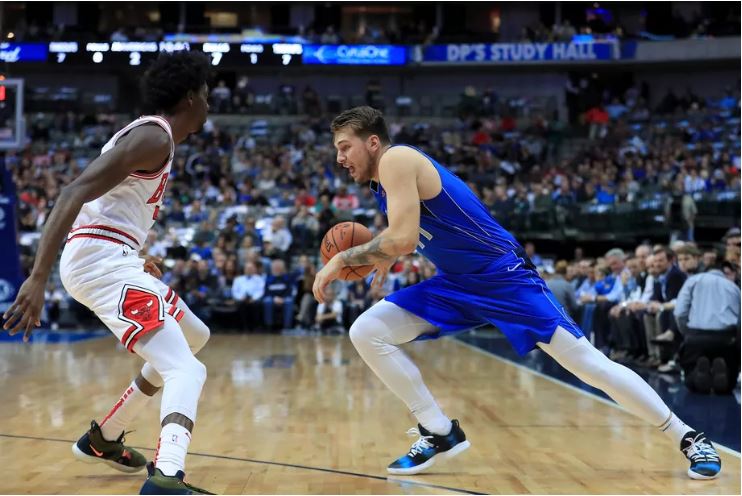Spend an afternoon combing through pre-draft scouting reports of Dallas Mavericks rookie sensation Luka Doncic, and you’ll notice a common theme.
ESPN’s Mike Schmitz — the gold standard of draft analysts — wrote that Doncic “lacks explosiveness for a guard or wing” and “isn’t the most functional athlete.” Sports Illustrated’s Jeremy Woo noted that Doncic’s “athletic ability has come into question.” NBADraft.net said Doncic “can be considered a marginally average athlete by NBA standards” and suggests “his first step is slow even for European standards.”
A prophetic Nov. 2017 Sporting News article wondered if “a slew of gifted freshmen” who are all “more athletic than Doncic” would leapfrog him by draft time
Even Doncic’s peers spoke of him in the same vein. In the weeks before the June draft, Uproxx’s Oliver Maroney asked five American-born players plying their trade overseas to give their own Doncic scouting report. Their answers included 11 forms of the word “athletic” and two more references to him not being “explosive.” (Control + F it, if you don’t believe me).
If you’re looking for a reason three teams passed on a teenager who was named the most valuable player in the second-best league in the world, this is it.
And that concern has some merit, at least by the widely accepted definition of these hoops buzzwords. This clip of Doncic playing against NBA two-way player Jordan McRae in Europe last season sure displayed what most would call a lack of athleticism.
Maybe it’s because he’s been able to overcome his lack of athleticism. Or maybe it’s because we actually define athleticism in an incredibly narrow way.
Consider the most damning sentence of all those links: NBADraft.net’s claim that Doncic’s “first step is slow even for European standards.” That phrase — “first step” — has evolved into hoops shorthand to describe any element of athleticism, whether it’s 0-to-60 speed, leaping ability, power, strength … take your pick.
Taken literally, though, a “first step” is just that: the beginning of a multi-stage process. Players with dynamic first steps, like Doncic’s teammate Dennis Smith Jr., still have to take additional steps to finish their moves. Even Giannis Antetokounmpo can’t cover the entire length of the floor in one leap.
Yet you never hear about how Smith or anyone else needs to improve their “second step,” “third step,” or “fourth step” to maximize the head start they gives themselves. You instead hear about how their first step shows their athleticism, and every other “step” is grouped into an entirely different category like “craft” or “skill” that may or may not get better with experience and hard work. These terms and “first step” function as basketball antonyms.
Doncic is proof that they shouldn’t be. It’s true that Doncic’s “first step” is weak. Defenders can anticipate it and beat him to the spot, even with lots of space.
But the difference between Doncic and other players that do have elite first steps is Doncic actually takes the term literally. Like a boxer that sets up his opponents with jabs before delivering the killer blow, Doncic uses the first step to get himself in position to drop his version of a right hook. Let’s call it his last step.
Doncic’s last step packs one hell of a punch. Look how far spindly Timberwolves wing Josh Okogiestaggered after this Doncic “last step.”
Stop the clip at the very moment Doncic’s toe hits the floor for the final time, and it’s striking how much flexibility Doncic is showing. If you drew a straight line between his front and back feet, it might break your tape measure.
But rather than lose his balance, Doncic had the power in his legs to rise up as his defender stumbled backwards. He beats his man off the dribble, which is supposedly his weakness. He just does it by gaining separation at the end of the move, not the beginning.
You see that same process — the first step setting up the decisive, large final steps — throughout Doncic’s game. He uses that method to beat defenders in the open floor.
He also uses it in tight spaces, whether it’s to ward off shot-blockers like DeAndre Ayton ...
... or to power through tough defenders like Robert Covington, an all-defense selection last season.
The key is that Doncic deploys the last step to accelerate and decelerate, to equally devastating effect. The same gallop that leaves Covington and Mike Muscala in the dust also digs into Ayton, shoving him out of the play. Doncic goes from this position.
Doncic’s last step serves him well in pick-and-roll situations, activating both his scoring and his supernatural vision. He uses a series of choppy stomps to run his defender into a screen, then pushes forward with those final long jumps to go through or around the help. Without those shorter steps, Doncic isn’t in position to finish defenders off. Without that final, long step, those shorter steps can easily be anticipated.
It takes Doncic seven steps on a curvy route to get from out of bounds to the hole. Four run his man into DeAndre Jordan’s screen. The fifth takes Doncic inside the arc, but is purposely short to plant for lift off. It’s only at Steps Nos. 6 and 7 when Doncic gallops from 20 feet away to deep into the paint, and it’s only that final step that powers through Towns’ chest for the bucket and the foul.
And Doncic’s last step also works against defenders who try to close his space. When quick young Bulls big man Wendell Carter Jr. tried to cut off Doncic’s sideline drive, Doncic simply planted that last step right between his legs to open a passing lane.
Few scouts would consider Doncic more athletic than Carter, yet how do you explain Doncic creating that kind of separation despite getting beat to the spot? Maybe it’s an example of Doncic’s craft winning out over Carter’s quickness. Or, maybe Doncic taking that large step to knock Carter back and balancing himself to make the pass is its own form of athleticism.
I vote the latter, especially when you consider how Doncic uses the same last step to go backwards as well, whether off the catch or the dribble.
How many people on this planet can do the splits before launching even a crumpled up piece of paper into a trash bin from 26 feet away, let alone a basketball through the net with seven-plus feet of arms in their periphery? (Try it yourself. Just don’t hold us liable for any shredded ligaments that result).
A universal definition of athleticism encompasses traits like strength, flexibility, and balance, all categories in which Doncic would rate in the 90th (or better) percentile among NBA players.
But we too often fall for the trap of associating the term with flying through the air or quick-twitch muscles that switch on before the opponent’s. We should realize the limitations this places on our analysis, and yet we still can’t help ourselves. We make the rhetorical assumption that many of the 450 most successful professional athletes in the world somehow made it to the pinnacle of their sport by overcoming a lack of “athleticism.”
That assumption is becoming especially costly as the game is increasingly played on the move and in space, two places where 0-to-60 speed and leaping ability matters less. Last June, a FanPost arguing on Doncic’s behalf on SB Nation’s Kings site Sactown Royalty noticed something funny. Six of the 10 small forwards ranked highest in ESPN’s Real Plus-Minus last season had predraft scouting reports that questioned their “athleticism,” as did the league’s reigning MVP (James Harden) and its 2016-17 Defensive Player of the Year (Draymond Green). This intrepid Kings fan acknowledged that Doncic’s “athletic” concerns were legitimate, but cited these examples to posit the following:
What it DOES mean is that perhaps elite or even good athleticism isn’t as necessary to success in the NBA as many people seem to think, and perhaps we should be more forgiving of a perceived lack of athleticism in prospects, especially if they make up for it with skills like playmaking ability, elite passing, or high BBIQ.
The Kings, of course, passed on Doncic to select Marvin Bagley, a pogo-stick big man who is still learning how to actually play the game. Maybe if the Kings saw Doncic’s positive traits as different forms of athleticism instead of gimmicks used to mask a fatal flaw, they’d be enjoying Luka-mania instead of the Mavericks.



